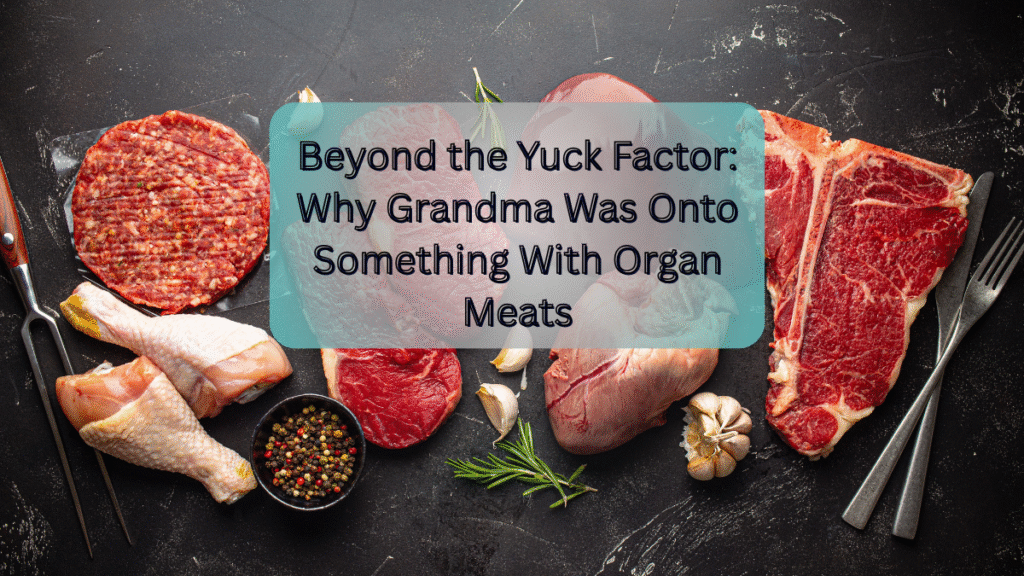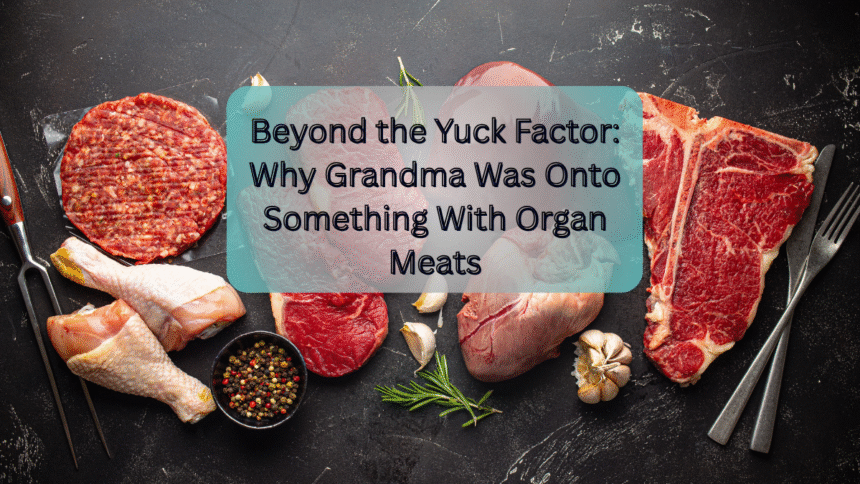Yuck Factor
Remember that smell wafting from Grandma’s kitchen? The one that made you wrinkle your nose and bolt for the backyard? Chances are, she was cooking up liver and onions, or maybe simmering a pot of hearty beef heart stew. For generations, organ meats – often called offal – were prized nutritional powerhouses, central to traditional diets worldwide. But somewhere along the line, in our quest for boneless, skinless chicken breasts and lean steaks, we largely relegated these treasures to the realm of “weird” or “unappetizing.”
It’s time for a rethink. What if I told you that bypassing the liver, heart, kidney, and even brain (yes, brain!) at the butcher counter means missing out on some of the most concentrated, bioavailable nutrition nature provides? Buckle up, because the health benefits of incorporating organ meats into your diet are truly surprising and compelling.

The Nutritional Powerhouse Punch: Why Offal Outshines Muscle Meat
Think of muscle meat (like your standard steak or chicken breast) as the reliable workhorse. It’s good protein, sure. But organ meats? They’re the Olympic athletes of the food world, packed with staggering amounts of essential vitamins, minerals, and unique compounds often difficult to find elsewhere in such potent forms. Here’s the lowdown on some superstar organs and their surprising benefits:
- Liver: Nature’s Multivitamin (Especially Beef & Chicken)
- Vitamin A Overload (in the best way): Liver is hands-down the richest source of preformed Vitamin A (retinol) you can eat. Just a small 3-ounce serving of beef liver can provide well over 100% of your daily needs. Why care? Vitamin A is crucial for sharp vision (especially night vision), a robust immune system that fights off invaders, glowing skin health, and even reproductive health. Forget carrots for a moment; liver reigns supreme here.
- B-Vitamin Bonanza: It’s bursting with B vitamins, particularly B12 (essential for energy, nerves, and blood cells), Folate (B9) (vital for DNA and cell growth), Riboflavin (B2), and Niacin (B3). This complex works synergistically to combat fatigue, support brain function, and boost metabolism.
- Iron You Can Actually Use: Liver provides heme iron, the form most easily absorbed by your body. This is a game-changer for anyone struggling with iron deficiency anemia or needing sustained energy levels. Pair it with some vitamin C (like a squeeze of lemon) for even better absorption.
- Copper & More: It’s also rich in copper (needed for iron utilization and energy), choline (critical for brain and liver health), and trace minerals like selenium and zinc.
- Heart: The Energizing Muscle
- CoQ10 Champion: Heart meat is exceptionally rich in Coenzyme Q10 (CoQ10), a powerful antioxidant vital for cellular energy production, particularly in your own heart muscle! CoQ10 levels naturally decline with age, and supplementation can be expensive. Eating heart is a delicious, natural solution supporting cardiovascular health and overall vitality.
- Dense Protein & B12: Like other muscle meats, heart is an excellent source of high-quality protein and vitamin B12, but often in even more concentrated amounts. It’s also a good source of iron and zinc.
- Surprisingly Mild: If you’re organ-meat wary, heart is a fantastic starting point. Its texture is similar to a slightly denser steak, and its flavor is robust but clean, often described as “beefy.”
- Kidney: The Detoxifier (But Not How You Think!)
- Selenium Superstar: Kidneys (especially beef and lamb) are one of the absolute best food sources of selenium, a critical mineral and antioxidant that protects cells from damage, supports thyroid function, and plays a role in immune health.
- B-Vitamins & Iron: Also packed with B12, Riboflavin (B2), and heme iron, kidneys offer a similar nutritional boost to liver, though often in slightly lower concentrations. They also provide good amounts of zinc.
- Beyond the Usual Suspects: Brain, Sweetbreads & More
- Brain: Historically prized for cognitive support, brain is rich in DHA (an omega-3 fatty acid crucial for brain development and function) and phosphatidylcholine. Important Note: Sourcing is critical due to disease risks (like BSE); only consume brain from trusted, verified sources if you choose to explore it.
- Sweetbreads (Thymus/Pancreas): Delicate and flavorful, sweetbreads offer a good mix of protein, vitamin C (surprisingly!), selenium, and zinc.
- Tongue: While technically muscle, it’s often grouped with offal. It’s incredibly tender when cooked slowly and is a great source of B12, zinc, and iron.
Addressing the Elephant in the Room: Common Concerns
Video Credits
Let’s tackle the hesitations head-on:
- “But the Taste/Texture!” This is the biggest hurdle. The key is preparation. Soaking liver in milk or lemon water can mellow its flavor. Grinding organs into ground meat blends (like adding liver to burgers or meatloaf) is a stealthy way to benefit. Pâtés and mousses are classic, delicious preparations. Heart and tongue, when cooked properly (often slow-cooked), have very approachable textures. Start small!
- “Aren’t Organs Full of Toxins?” This is a persistent myth. While the liver processes toxins, it doesn’t store them. Toxins are filtered and excreted. The real concern is the animal’s health. Source matters immensely. Choose organs from pastured, grass-fed, or organically raised animals. Their livers will be nutrient-dense, not toxin-laden.
- “What About Cholesterol?” Dietary cholesterol (found in animal foods) has a much smaller impact on blood cholesterol for most people than once thought. Saturated fat intake and genetics play larger roles. Organ meats are incredibly nutrient-dense relative to their calorie content. Moderation and overall dietary balance are key.
- Purines & Gout: Organ meats are high in purines, which can break down into uric acid. Individuals with gout or a history of kidney stones should consume them cautiously or consult their doctor.
Practical Tips: How to Embrace the Offal Advantage
Ready to dip your toe (or fork) in? Here’s how to make organ meats work for you:
- Start Small & Sneaky: Begin by adding small amounts (1-2 oz) of finely chopped or ground liver or heart to dishes like chili, Bolognese sauce, meatballs, or shepherd’s pie. You likely won’t notice the taste.
- Master Pâté: Homemade chicken liver pâté is relatively simple, incredibly delicious spread on crackers or crusty bread, and a crowd-pleaser (often without people realizing what they’re loving!).
- Try Heart: Slice beef heart thinly against the grain for stir-fries or fajitas, or cube it for stews. Its lean, dense texture holds up well.
- Explore Desiccated Organs: If the idea of cooking organs is still too much, high-quality desiccated organ supplements (like capsules of freeze-dried liver) offer a concentrated, convenient way to get many benefits. Always choose reputable brands sourcing from grass-fed/pastured animals.
- Source Wisely: This cannot be overstated. Build a relationship with a local farmer, butcher, or trusted online supplier known for ethical, sustainable, and healthy animal practices. Look for grass-fed, pasture-raised, and organic certifications where possible.
- Cook Them Right: Overcooking makes organs tough and intensifies strong flavors. Liver cooks very quickly – sear it hot and fast (minutes per side). Heart benefits from slow, moist cooking (braising, stewing) to tenderize. Use flavorful herbs, spices, onions, garlic, and wines to complement their unique tastes.
- Moderation is Key: Due to their extreme nutrient density (especially Vitamin A in liver), you don’t need to eat large quantities. Including a small serving (1-4 oz) once or twice a week can provide significant benefits. Think of them as a potent supplement, not a main course staple.
The Takeaway: Reconnecting with Ancestral Wisdom
Incorporating organ meats isn’t about forcing down something unpleasant; it’s about rediscovering a lost pillar of ancestral nutrition. These “odd bits” offer unparalleled concentrations of vital nutrients – Vitamin A for vision and immunity, heme iron for energy, B vitamins for metabolism and brain health, CoQ10 for heart vitality, and selenium for antioxidant defense – often in forms your body can readily use.
By sourcing responsibly, starting small, and learning simple, delicious preparation methods, you can unlock these surprising health benefits. It’s a step towards more sustainable, nose-to-tail eating that honors the whole animal and taps into the deep nutritional wisdom of generations past.
Ready to give organ meats a try? What’s the one organ you’d be most curious to taste? Share your thoughts (or your favorite offal recipe!) in the comments below! If you found this dive into nutrient-dense foods surprising, subscribe to our newsletter for more insights on traditional foods and optimizing your health naturally. Don’t forget to share this post with a friend who needs to know about the power of offal!











